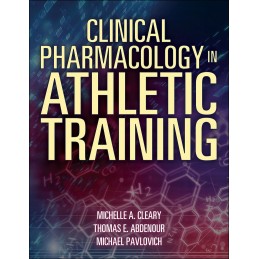Athletic trainers have a responsibility to provide high-quality pharmaceutical care while meeting both legal and ethical requirements.
Clinical Pharmacology in Athletic Training empowers athletic trainers with a functional understanding of pharmacology that enables them to formulate a treatment plan intended to mitigate disease and improve the overall health of their patients. This text incorporates the most up-to-date content from the 2020 Commission on Accreditation of Athletic Training Education (CAATE) standards, and it emphasizes interprofessional practice to enable future and current athletic trainers to collaborate with other health professionals in a manner that optimizes the quality of care.
Clinical Pharmacology in Athletic Training begins by addressing drug legislation and the legal aspects of the athletic trainer’s role in sport medication. The text provides an overview of pharmacokinetics and pharmacodynamics with an emphasis on concepts relevant to clinical practice. Students are introduced to the generic and brand names, general classifications, and appropriate administration of drugs and are guided toward appropriate online reference materials. Part II of this text describes common medications for pain, inflammation, and infections. Part III includes medications for specific conditions, including respiratory, cardiovascular, gastrointestinal, neurological, gynecological, and mental health conditions. The text also includes current information on opioid analgesics, cannabis, and cannabinoid-based medications.
Clinical Pharmacology in Athletic Training teaches students to administer appropriate pharmacological agents for the management of the patient’s condition. The information includes indications, contraindications, dosing, interactions, and adverse reactions. The following features are included to aid in the learning process::
- Chapter objectives set the stage for the main topics covered in the chapter.
- Key terms are boldfaced to indicate terms of special importance, and a glossary of definitions is included at the back of the book.
- Red Flag sidebars highlight warnings and precautions for certain medications or medicolegal issues.
- Evidence in Pharmacology sidebars highlight recent research regarding medications.
- Clinical Application sidebars present real-life stories from the field of athletic training.
- Case studies highlight specific therapeutic medication applications and are accompanied by questions that prompt readers to think critically about the issues presented.
- Quick reference drug tables describe medication types, generic and brand names, pronunciations, common indications, and other special considerations for the athletic trainer.
Over the past decade, there has been an increased emphasis on pharmacology in athletic training.
Clinical Pharmacology in Athletic Training will equip students with appropriate skills and competencies, prepare them to meet patient needs, and enable them to work in interprofessional teams.


 Dostawa
Dostawa
 Płatność
Płatność
 Zwroty
Zwroty
